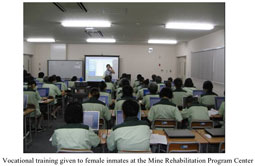(1) Actual current situations of overcrowding
As mentioned in this Chapter Sections1 to 3 inclusive, penal institutions across the country are overcrowded. Looking at the average daily number of inmates in the entire penal institutions, the number was 50,091 (including 2,539 females) in 1997 increasing to 80,335 (including 5,003 females) in 2006, an increase of 30,244 (including 2,464 females) or in other words 60.4% (97.0% for females) over the last 10 years. In comparison, the imprisonment capacity was 64,404 (the occupancy rate being 77.8%) in 1997 and increased by 14,971 (23.2%) to 79,375 (the occupancy rate being 101.2%) in 2006. However, it has not caught up with the growth in the number of inmates (Source: The Judicial System Department, Minister's Secretariat, Ministry of Justice).
Overcrowding has increased burdens on officials in penal institutions. The burden rate per penal institution official (the rate obtained by dividing the average daily number of persons accommodated in overall penal institutions by overall fixed number of officials of relevant fiscal year) increased significantly from 2.93 in 1997 to 4.48 in 2006. (Source: The Correction Bureau, Ministry of Justice).
(2) Opening of penal institutions using the PFI method
The Private Finance Initiative (PFI) is a new method to construct, maintain, and operate public facilities, by utilizing funds and know-how of the private sector. In the U.K. and the U.S., private funds have already been utilized for the maintenance and management of penal institutions.
In Japan, from the standpoint of alleviating the problem of overcrowding, a new system was looked for in order to operate penal institutions and the necessity of utilizing the PFI method in maintaining and operating penal institutions was deliberated based on the
Act for Promotion of the PFI Management Method for Public Facilities (Act No. 117 of 1999), which was established with the purpose of developing social capital in an efficient and effective manner.
As a result, the “Mine Rehabilitation Program Center”, as the first PFI penal institution, was built. This center, the first penal institution utilizing private capital in Japan, started operations in April 2007.
Under the policy to establish “penal institutions with public understanding and support” through “management with involvement of both public and private sectors” and “coexistence with local communities,” the “System for Special Zones for Structural Reform” has been utilized for this Center and private sector's know-how has been fully utilized not only in designing and constructing facilities but also in operating them, and this Center accommodates 1,000 inmates (500 males and 500 females) who have not developed their criminal tendency yet.
As the second PFI penal instituton project, construction is under way for the “Shimane Asahi Rehabilitation Program Center (tentative name)” to accommodate 2,000 male inmates who have not developed their criminal tendency yet in Hamada City, Shimane Prefecture, and it is scheduled to open in October 2008.
Furthermore, as regards “Kitsuregawa Rehabilitation Program Center” (Sakura City, Tochigi Prefecture) and “Harima Rehabilitation Program Center” (Kakogawa City, Hyogo Prefecture) which the government has constructed at national expense, their management are also to be conducted utilizing the PFI method, and they started their operation, including part of the business of the existing penal institutions in their neighborhood as the third and fourth projects in October 2007 (Source: The Correction Bureau, Ministry of Justice).
These new types of penal institutions are expected to further enhance correctional treatment under collaboration with local communities.
Vocational training given to female inmates at the Mine Rehabilitation Program Center
